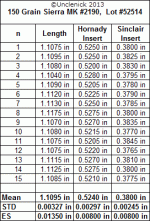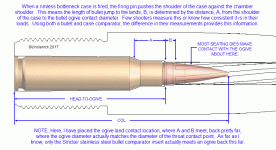Alright, so, i just fired my new lapua brass for the first time. I clean them all up nice, run them through my hornady full-resizing die, and put them on a block.
I take my digital caliper, and measure each case, end to end. According to SAAMI in my reloading book, 338 lapua max cartridge length is 2.724''. I measure each case to see if they are at or below that. They all are, but are not all the same exact length.
So, I prime them and load some n570. I adjust my bullet seating die, and place one in. Once I seat it, the COL is 3.677. I don't adjust the seating die. Next is 3.681, then 3.672, then 3.680. Is it ok to leave the seating die consistent (and then the whole catridge length will vary between each round slightly), or do you adjust the bullet seating die to adjust the COL of your case?
I found myself constantly adjusting my seating die tonight because I'd raise it a bit, then the next case would be slightly longer, so the bullet would raise the COL over the saami spec (3.681), and then I'd have to adjust it lower slightly again.
Unless I make sure every case is the same exact length before I load it, there's going to be a slight COL difference. Suggestions? What is your process?
I take my digital caliper, and measure each case, end to end. According to SAAMI in my reloading book, 338 lapua max cartridge length is 2.724''. I measure each case to see if they are at or below that. They all are, but are not all the same exact length.
So, I prime them and load some n570. I adjust my bullet seating die, and place one in. Once I seat it, the COL is 3.677. I don't adjust the seating die. Next is 3.681, then 3.672, then 3.680. Is it ok to leave the seating die consistent (and then the whole catridge length will vary between each round slightly), or do you adjust the bullet seating die to adjust the COL of your case?
I found myself constantly adjusting my seating die tonight because I'd raise it a bit, then the next case would be slightly longer, so the bullet would raise the COL over the saami spec (3.681), and then I'd have to adjust it lower slightly again.
Unless I make sure every case is the same exact length before I load it, there's going to be a slight COL difference. Suggestions? What is your process?


